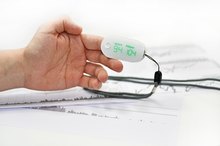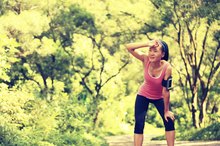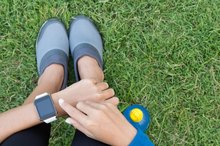What Causes a Low Pulse Oximeter Reading in Children?
A pulse oximeter measures the amount of hemoglobin saturated with oxygen. Oxygen saturation measured by pulse oximetry (SpO2) between 96 and 100 percent are considered normal, according to nursing instructor Kathy Lawrence, M.S.N. of the University of Texas Medical Branch 23. A reading of 100 percent means that all the hemoglobin in the red blood cells is carrying oxygen molecules. Children with low oxygen saturation don't have enough oxygen in the hemoglobin, usually because of respiratory problems. Mechanical problems can also cause low readings.
Respiratory Problems
Most children with low oxygen saturation have a respiratory disorder. Any disease that interfere with oxygen flow through the lungs can cause a low oxygen saturation, including conditions such as pneumonia, croup or chronic diseases such as cystic fibrosis or bronchopulmonary disease, which makes the lungs stiff. Newborns who breathe irregularly or who have apneic periods where they stop breathing may also have low oxygen saturation. Children with asthma may have normal oxygen saturation, except when they have an asthma attack. Giving supplemental oxygen normally raises the oxygen saturation in children with respiratory disease, although severe asthma or lung damage, which narrows and constricts the tubes in the lungs, can make it difficult for oxygen to reach the lungs.
- Most children with low oxygen saturation have a respiratory disorder.
- Children with asthma may have normal oxygen saturation, except when they have an asthma attack.
Poor Tissue Perfusion
Disadvantages of Pulse Oximetry
Learn More
If your child has poor tissue perfusion, the pulse oximeter will have difficulty reading the oxygen saturation accurately. Poor tissue perfusion means that not enough blood is flowing to an area. Extreme cold, decreased blood volume due to blood loss or dehydration, very low blood pressure, heart failure or diseases that disrupt blood flow to the arms and legs can all cause low oxygenation saturation due to poor perfusion. An irregular heartbeat can make it difficult for the pulse oximeter to record an accurate reading. If the child has a blood pressure cuff on the same arm as a pulse oximeter, the cuff interferes with blood flow when it pumps up, causing low readings.
- If your child has poor tissue perfusion, the pulse oximeter will have difficulty reading the oxygen saturation accurately.
Movement
If you're child is moving around or crying, SpO2 may be artificially low because the machine can't lock onto the signal long enough to read it. During a seizure, SpO2 will also fall, both because of decreased oxygenation and because of the child's movement. Vibrations in a moving vehicle, plane or helicopter, during a medical transport, for instance, will also interfere with readings.
Other Problems
How to Use a Finger Pulse Oximeter
Learn More
If your child has sickle cell anemia, the irregular and abnormal shapes of the red blood cells can cause SpO2 to be either too high or too low. A number of mechanical problems can also interfere with the pulse oximeter, causing low readings. Very bright light shining on the pulse oximeter can skew the readings, as can very dark nail polish on a fingernail. Dark skin color does not cause low readings, however. Pulse oximeters do not measure carbon dioxide and can't diagnose respiratory failure due to carbon dioxide retention, states S.J. Fearnley of the Department of Anaesthetics at Torbay Hospital in the United Kingdom 1.
- If your child has sickle cell anemia, the irregular and abnormal shapes of the red blood cells can cause SpO2 to be either too high or too low.
- Pulse oximeters do not measure carbon dioxide and can't diagnose respiratory failure due to carbon dioxide retention, states S.J.
- Fearnley of the Department of Anaesthetics at Torbay Hospital in the United Kingdom 1.
Related Articles
References
- Pandya NK, Sharma S. Capnography And Pulse Oximetry. [Updated 2020 Jan 30]. In: StatPearls [Internet]. Treasure Island (FL): StatPearls Publishing; 2020 Jan-. Available from: https://www.ncbi.nlm.nih.gov/books/NBK539754/
- Castro D, Keenaghan M. Arterial Blood Gas. [Updated 2020 Feb 20]. In: StatPearls [Internet]. Treasure Island (FL): StatPearls Publishing; 2020 Jan-. Available from: https://www.ncbi.nlm.nih.gov/books/NBK536919/
- Torp KD, Simon LV. Pulse Oximetry. [Updated 2019 Apr 28]. In: StatPearls [Internet]. Treasure Island (FL): StatPearls Publishing; 2020 Jan-. Available from: https://www.ncbi.nlm.nih.gov/books/NBK470348/
- Plüddemann A, Thompson M, Heneghan C, Price C. Pulse oximetry in primary care: primary care diagnostic technology update. Br J Gen Pract. 2011;61(586):358–359. doi:10.3399/bjgp11X572553
- Shah SA, Velardo C, Farmer A, Tarassenko L. Exacerbations in Chronic Obstructive Pulmonary Disease: Identification and Prediction Using a Digital Health System. J Med Internet Res 2017;19(3):e69.
- Vold ML, Aasebø U, Wilsgaard T, Melbye H. Low oxygen saturation and mortality in an adult cohort: the Tromsø study. BMC Pulm Med. 2015;15:9. Published 2015 Feb 12. doi:10.1186/s12890-015-0003-5
- Pandya NK, Sharma S. Capnography And Pulse Oximetry. [Updated 2020 Jan 30]. In: StatPearls [Internet]. Treasure Island (FL): StatPearls Publishing; 2020 Jan-.
- Castro D, Keenaghan M. Arterial Blood Gas. [Updated 2020 Feb 20]. In: StatPearls [Internet]. Treasure Island (FL): StatPearls Publishing; 2020 Jan-.
- Torp KD, Simon LV. Pulse Oximetry. [Updated 2019 Apr 28]. In: StatPearls [Internet]. Treasure Island (FL): StatPearls Publishing; 2020 Jan-.
- Johns Hopkins University Medicine. Pulse Oximetry. 2019.
- Shah SA, Velardo C, Farmer A, Tarassenko L. Exacerbations in Chronic Obstructive Pulmonary Disease: Identification and Prediction Using a Digital Health System. J Med Internet Res. 2017;19(3):e69. Published 2017 Mar 7. doi:10.2196/jmir.7207
- Shah SA, Velardo C, Farmer A, Tarassenko L. Exacerbations in Chronic Obstructive Pulmonary Disease: Identification and Prediction Using a Digital Health System. Eysenbach G, ed. Journal of Medical Internet Research. 2017;19(3):e69. doi:10.2196/jmir.7207
- Fahy B, Lareau S, Sockrider M. Pulse Oximetry. American Journal of Respiratory and Critical Care Medicine. American Thoracic Society. 2011;184: 1.
Writer Bio
A registered nurse with more than 25 years of experience in oncology, labor/delivery, neonatal intensive care, infertility and ophthalmology, Sharon Perkins has also coauthored and edited numerous health books for the Wiley "Dummies" series. Perkins also has extensive experience working in home health with medically fragile pediatric patients.








